|
SOME ECOLOGICAL
OBSERVATIONS ON SLOW-SWIMING NEKTON WITH EMPHASIS ON PENAEID SHRIMP IN A SMALL
MEXICAN WEST COAST ESTUARY
Trabajo recibido el 7 de agosto de 1978 y
aceptado para su publicación el 6 de noviembre de 1978.
HAROLD LOESCH
UNESCO Marine
Biologist. Instituto Tecnológico y de Estudios Superiores de Monterrey.
Escuela de Ciencias Marítimas y Tecnología de Alimentos, Guaymas,
México. Permanent address: 1232 Dahlia Strect, Baton Rouge, La. 70808,
USA.
Cuarenta especies de peces y 18 especies de invertebrados
fueron capturados por arrastre y luego identificadas. Los peces fueron
más comunes en agosto cuando se capturaron 19 especies, mientras que los
invertebrados lo fueron en mayo, al capturarse 10 especies. La biomasa en las
estaciones dentro del estero fue cerca del doble que la estación de
control, localizada fuera del estero. La mayor biomasa se encontró
durante los meses cálidos de mayo a noviembre.
Las
variaciones de salinidad fueron mínimas en las dos estaciones superiores
del estero, variando únicamente de 34 a 39 partes por mil. La
temperatura más alta se registró en julio (32.7ºC) y la
más baja en enero (17ºC) con cambios mensuales graduales entre
estos extremos. Penaeus stylirostris se encontró en
el Estero del Soldado, Sonora, únicamente durante los meses de agosto,
septiembre y octubre. Se encontró solo en las estaciones 1 y 2,
localizadas en la parte interna del estero. Penaeus californensis se
encontró durante los 12 meses del año. El 98% de esta captura se
logró en las dos estaciones internas del estero, donde sólo el
50% del esfuerzo de muestreo tuvo lugar El crecimiento de P.
californiensis fue estimado en 1 mm. por día.
Callinectes arcuatus fue capturado durante 11 meses en
muestreo, y estuvo ausente sólo en octubre. Se presume que pudo haber
estado presente en octubre. Individuos de tallas grandes se encontraron en el
estero durante los meses cálidos de mayo a noviembre.
Forty species of fish and 18 species of invertebrates were caught by
trawl and identified during monthly sampling taken from May 1977 through May
1978. Fish were most common in August when 19 species were caught.
Invertebrates were most common in May when 10 species were caught.
Biomass at the station inside the estuary was about twice that of the
control station located just outside the estuary. Highest biomass was found
during the warmer months of May to November.
Salinity
variation was minimal at the upper two stations of the estuary, varying only
from 34 to 39 parts per thousand. Temperature was warmest in July at
32.7º and coldest in January at 17ºC with gradual monthly changes
beteween these extremens.
Penaeus
stylirostris was found in Estero Soldado, Sonora, only during the
months of August, September and October. It was found only at stations 1 and 2,
located in the upper estuary. P. californiensis was found in
Estero Soldado during the twelve months of the year. The upper two stations of
the estuary, where only 50% of the sampling effort took place, yield 98% of the
total catch of this species. Growth of P.
calíforniensis was estimated at one millimeter per
day.
Callinectes arcuatus was taken
during eleven sampling months, and was absent only in October. It is presumed
to have been present in October. Larger individuals were found in the estuary
during the warmer months of May to November.
Only two species of peneid shrimp were found inthe estuary during this study. Penaeus californiensis Burkenroad is generally found in all stages of its life in almost marine salinity conditions. However, in the small estuary Soldado located near Guaymas, Sonora, Mexico, this shrimp was the most common organism sampled with an otter trawl and was found in the estuary during all months of the year. This estuary has about the same salinities as does the Gulf of California, into which it opens. P. californiensis is the dominant species in the coastal trawler fishery in the Gulf of California. P. stylirostris Stimpson typically inhabit brackish waters as juveniles, but a population entered Estero Soldado in August at about 100 mm length and stayed for three monts before leaving. During September and October they were pursued by cast net fishermen. In the northern and central Gulf of California the commercial catch is made up, of mostly P. californiensis and P. stylirostris, with the first comprising about 80% of the commercial catch (Rodríguez de la Cruz 1976b). P. breviorstris Rathbun is found in more saline arcas, and P. vannamei Boone is found during its post larval and juvenile stages in fresh water lagoons where it is caught in traps, and where it may make up, 90% of the catch during the wet season generally July to September (Chapa and Soto 1969). In waters adjavent to Mexican lagoons P. vannamei may constitute a large proportion of the trawl catch (Soto 1973). In the southern Gulf the commercial catch is principally P. brevirotris and P. vannamei (Synder-Conn and Brusca 1975). Loesch and Avila (1966), in investigating a generally hypersaline estuary in Ecuador whose annual salinity ranged from 9.2 to 73.8% (with all of the year above 58%o except one month) , found P. vannamei the dominant organism in that estuary during the low saliníty month as well as the high salinity periods. Considering the fact that P. vannamei makes up less than 5% of the Penaeus caught in Ecuador (Loesch and Cobo 1966) this indicates that young P. vannemei can tolerate hypersaline conditions, and is tolerant to drastic salinity changes. juvenile Penaeus of varios species were stocked in a large commercial shrimp farm in Ecuador. About 95% of those harvested were P. vannamei, indicating that this species can better survive conditions found in aquaculture ponds than other species of Penaeids that were stocked with it (Cobo, personal comm.). Another nearby estuary investigated in Ecuador that had an annual salinity range of 23-29%o had as a dominant organism P. californiensis (Loesch and Avila 1966). In the state of Sinaloa, just south of Sonora, some work was done in the Huizache-Caimanero lagoon complex on the biology of shrimp (Chapa, 1966; Soto, 1969, Lluch et al., 1972; Soto and Bush, 1973) and on population studies of P. vannamei (Chapa and Soto, 1969; Edwards, 1977), and on patterns of immigration of post larvae from the sea (López, 1967; Soto, 1969; Cabrera, 1970; Macias, 1973; Ortega and Núñez, 1974) . To the north in Estero del Rancho, Sonora, Herrera (1972) found postlarvae P. stylirostris increased after a heavy rainfall. He found a relationship between low salinities and higher numbers of postlarvae. García (1967) worked with the fecundity of P. californiensis and P. stylirostris at Guaymas and Puerto Peñasco Rodriguez de la Cruz (1976a) studied the distribution of larval and porstlarval genera of the family Penaeidae. Rodriguez de la Cruz (1975) found the maximum recruitment of postlarvae of P. californiensis to be during July and August. Pico and Mathews (1975) in sampling adults of P. californiensis near the mouth of the Colorado River found that they were not dominant until November or December. At that time their average size was 135 mm. If they were spawned in July and 135 mm in November they would have grown a little over a millimeter a day. Rosales (1976) did some stomach analysis of some species of Penaeus in the open waters of the Gulf. Other studies have been made in the laboratory. However, few field studies have been made in Sonoran estuaries where there is a very low imput of fresh water. All of the rivers that had emptied into the Gulf in this area are now dammed up and the water used for agriculture. Almost none reaches the sea now. It would have been interesting to have data before the dams were built, but none exists. However, the presence of reefs of dead shells of Crassostrea corteziensis in areas (example near los Guasamas) where very few live oysters exist today gives testimony to changed environmental conditions. Edwards (1977) estimates growth of P. stylirostris in Mexico as 1.43 mm per day. My growth estimate for P. californiensis in this study is 1 mm per day. Growth rates of Penaeus spp from the Gulf of Mexico range from 0.8 to 2.5 mm per day (Loesch, 1965; Loesch and Jacob, 1970; Cook and Lindner, 1970; Jacob and Loesch, 1971; Williams, 1955; Zein Eldin and Aldrich, 1965; McCoy, 1968). Lluch (1974) found a mean grouth rate of 1.0 mm per day for P. vannamei up to 100 mm total length. Soto (1969) determined a wet season growth rate of 1.5 mm per day for P. vannamei. Soto (1969) found 8 groups of recruits entering the lagoon from late June to mid September or about one group, each spring tide. Jacob (1971) found P. aztecus entering his study arca in waves about two weeks apart. Edwards (1977) indicated a capture efficiency of a beam trawn for P. vannamei of 35%. Loesch et al. (1975) indicated a trawl efficiency of a third to a half for catching P. aztecus, a fourth for Micropogon undulatus and 6% for Leiostomus xanthurus. These are all slow swimming demersal forms, and are susceptible to capture by the trawl. Many species are, of course, never caught by the rawl. Edwards (1978) in a Sinaloa, Mexico, estuary found recruitment of Callinectes throughout the year, but it had its peak in the wet season. Edwards (1978) also presented a diagram of trophic relationship in the lagoon ecosystem. An ecological survery of Estero Soldado was conducted in November 1972 in which 354 species of marine plants and animals that inhabit the area were identified (Thomson 1973, mimeo report) . In my study presented here estimates of standing crops were not made. However, all tables are prepared with the catch of a 10 minute trawl haul. Loesch et al. (1975) calculated that a 4.9 meter trawl used in their study swept an arca 2.5 meters in width. For identification of the specimen the following publications were used. S.I.C. (1976), Brusca (1973 reprinted 1977), Thomson and Eger (1960), Thomson and McKibbin (1976), Miller and Lea (1972) and Avila and Loesch (1965). MATERIAL AND METHODSA shrimp trawl, towed by a flat-bottomed boat, powered by a 40 horsepower Evinrude outboard motor was used to sample monthly stations established in Estero Soldado, a small Mexican West Coast estuary about a square kilometer in area. No other means of sampling was used; therefore, the organisms captured were the slow swiniming bottom forms that are susceptable to capture with a shrimp trawl. The trawl had a lead line 3.6 meters long, a cork line 4.2 meters long, the stretched mesh in wings and tail was 40 milimeters, and the chain for the halter was 7.5 meters. ESTABLISHMENT OF STATIONSFour stations were established the first month. Station 1 is in the center portion of the enlarged upper bay area. Station 3 is in the channel leading through the flats located in the bottom area and has Rhizophora mangrove growing along the shoreline. Station 4 is in about eight meters of water in the Gulf of California just outside the mounth of the Estero Soldado. These three stations were successfully sampled and established as regular stations. Station 5 somewhat farther offshore in the Gulf of California was sampled unsuccessfully because of the large volumen of organic plant debris taken in the trawl and was therefore abandoner as a permanent station. 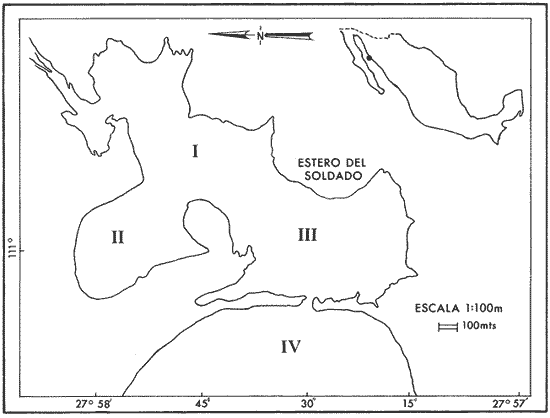 Fig. 1. Map of area of study, Estero del Soldado, Sonora, México. During the first two sampling months it was noted that most of the penaeid shrimp came from station 1. Because we were primarily interested in sampling the penaeid shrimp population another station was established in the proximity of station 1. Stantion 2 was established in the nearshore area of the upper bay near the Avicenia mangrove that grows along the shore in that area. These four stations were then sampled on a monthly basis for the balance of the one year's study. COLLECTION OF FIELD DATAThe shrimp trawl was towed for a minimum of ten minutes at each of the stations. All animals captured by the trawl were placed in containers and taken to the laboratory for identification, measuring, and weighing. Surface water temperatures were feasured with a mercury filled thermometer and read to the nearest half degree centigrade. Surface salinity was measured by using an American Optical Company refractometer read to the nearest half part per thousand salinity. EARLY TABULATION OF DATAThe organisms were brought to the laboratory in a fresh condition for identification. After a species was identified, each individual of that species was measured to the nearest millimeter for later preparation of lenght-frequency curves. After all specimens of a species were measured, the weight to the nearest 0.1 gram was taken for the species. These operations were all performed on fresh unpreserved specimens on the same day of capture. Data were kept in a monthly file. Further analysis of these data were not made until the end of the study. LATE TABULATION OF DATATables and figures were prepared using the basic data recorded earlier. Table 1 lists alphabetically the fish and the invertebrates caught during the year. Table 2 gives the gram biomass caught in a 10 minute trawl by month and station. Table 3 gives the grams of Penaeus californensis caught in a 10 minute trawl by month and station. Table 4 gives the number of P. californiensis caught in a 10 minute trawl. Tables 5 and 6 are tabulations of the weight in grams and the numbers of Callinectes arcuatus caught per station during the study. Table 7 is a tabulation of the number of specimens of the more abundant species taken per month of the study. 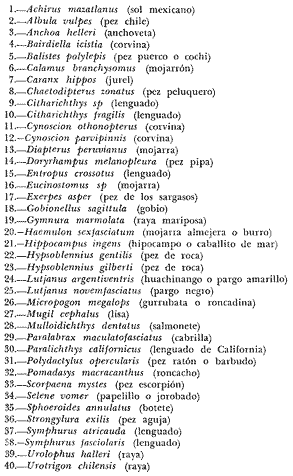 TABLA 1. GENERAL LIST OF FISH CAUGHT 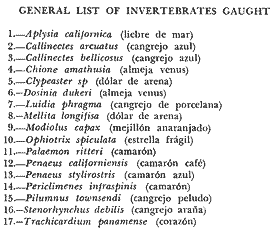 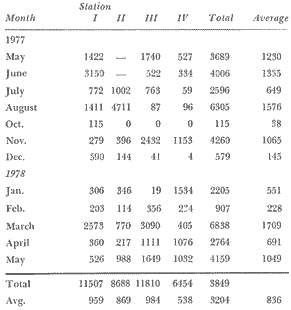 TABLE 2. GRAMS BIOMAS CAUGHT IN 10 MINUTE TRAWL BY MONTH AND STATION 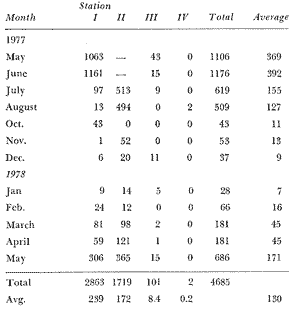 TABLE 3. GRAMS PENAUS CALIFORNIENSIS CAUGHT IN 10 MINUTE TRAWL HAUL BY MONTH AND STATION 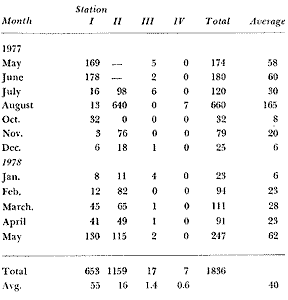 TABLE 4. NUMBER OF PENAEUS CALIFORNIENSIS CAUGHT IN A 10 MINUTE TRAWL HAUL BY MONTH AND STATION 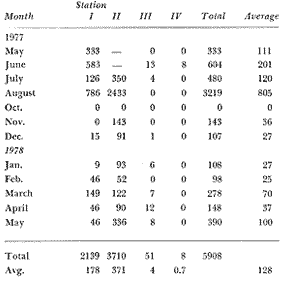 TABLE 5. GRAMS CALLINECTES ARCUATUS CAUGHT IN 10 MINUTE TRAWL HAUL BY MONTH AND STATION Figure 1 is a map of Estero Soldado, Sonora, Mexico, the study area. The average depth is about 0.8 meters. Figures 2 and 3 are length-frequency diagrams of Penaeus californiensis and Callinectes arcuatus. No fish were found in sufficient numbers throughout the year to warrant construction of length-frequency curves. Figure 4 gives the average monthly water temperatures and salinites of stations 1 and 2.  NUMBER OF CALLINECTES ARCUATUS CAUGHT IN A 10 MINUTE TRAWAL HAUL MONTH AND STATION RESULTS AND DISCUSSION
SPECIESDuring the study period of one year 40 species of fish and 18 species of invertebrates were caught by trawl and identified (Table l). The month in which most species of fish (19) were found was August. May yielded the most species of invertebrates (10) . Stations 1 and 2 (those in the upper estuary) contained the most species of fish susceptible to capture by trawl. The monthly average of fish for the year is a follows: station 1-5.5 species; station 2-5.4 species; station 32.1 species; and station 4-2.1 species. Tidal current was, strongest at station 3 and many species of fast-swimming fish were observed there but were not capture. 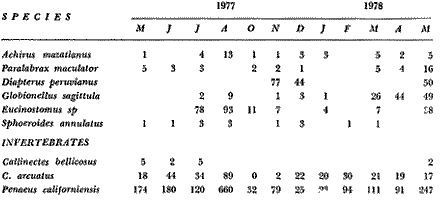 NUMBER OF SPECIMENS BY MAJOR SPECIES TAKEN PER MONTH DURING STUDY 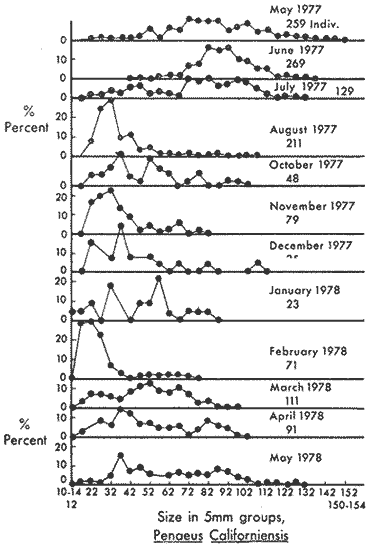 Fig.2 Length-Frequency diagram for penaeus californiensis 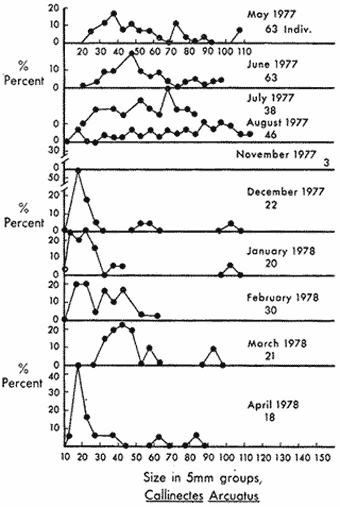 Fig.3 Lenght- Frequency diagram for callinecter arcautus Station 3 had most species of invertebrates susceptible to capture by the trawl. The average numbers of species of invertebrates caught monthly at the four trawl station were 3.5, 2.1, 3.2 and 0.2. 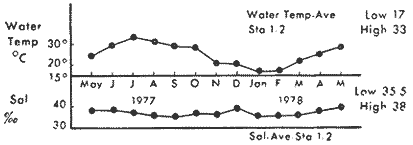 Fig.4. Average monthly water temperature and salininties of stations 1and 2 BIOMASSGenerally an average biomass of a little over a kilogram was caught in a 10-minute trawl from May to November (Table 2) when the water temperature was over 25ºC (Figure 4). October biomasses are very low and possibly the sample invalid because during that month we had a substitute boat captain. From December to April when temperature in general was colder than 25ºC biomass was lower, averaging about a half kilogram per trawl haul. A notable exception to these biomasses is found at Station 3 in March when three large specimens of Scorpaena weighing 2,358 grams were caught causing the March average to exceed a kilogram average per station. Station 1, 2 and 3, all in the estuary had an annual average 10-minute trawl catch of just under a kilogram, and station 4 in the Gulf of California just offshore had an annual average of just over half a kilogram, indicating that the standing crop susceptible to catch by small trawl is about twice as large inside the estuary as that located just outside the estuary (Table 2). SHRIMPPenaeus californiensis were caught every month of the year sampled. P. stylirostris were caught only during the month of August. During September and October a commercial fishery of about 15 small boats with about 30 cast nets participated in catching P. stylirostris. However, my shrimp trawl did not catch P. stylirostris during these months even though they were observed jumping in front and apparently over the trawl. As described previously, the trawl has a lead line longer than its cork line. This makes the lead line sweep in front of the cork line so the agile, larger shrimp could jump over the cork line and elude capture. Also the mesh is larger than of trawls used previously, so that the only small shrimp caught were those entangled in vegetation. This trawl design differs from that used in my previous studies (Loesch 1962). It is therefore believed that only the medium sized shrimp were adequately sampled. During August, 37 P. stylirostris ranging in sie from 72 to 130 milimeters were caught at station 2. These 37 shrimp weighed 269 grams. During the same month one P. stylirostris measuring 106 milimeters and weighing 10 grams was caught at station 1. These were the only P. stylirostris caught during the survey in Estero Soldado. Samples were not made in September as shrimp fishermen did not recognize our scientific collectors' permit and refused to allow us to sample. Duringo October a fishery inspector from the National Fisheries Institute accompanied us and we were not challenged by the fishermen. Large P. stylirostris were observed jumping over our shrimp trawl in October. However we observed fishermen commercially catching P. stylirostris during September and October. Therefore, the species was present in Estero Soldado in August, September and October. In November there were no commercial fishermen, we observed no large P. stylirostris leaping over our net, and we captured none. It can therefore be assumed that in late October or early November they migrated out of Estero Soldado. The water was becoming cooler and was 28.5ºC in October and 21ºC in November at the upper stations where the shrimp were found. All P. stylirostris were caught at stations 1 and 2, the same vicinity in which commercial fishermen worked. P. californiensis was taken during each month sampled. It was most common at the upper two stations. Station 1 produced 653; station 2, 1159; station, 3, 17; and station 4, 7 (Table 4). Thus the upper estuary produced shrimp each time sampled and produced 1,812 shrimp, whereas the lower estuary produced only 17 shrimp from December to July. These shrimp may have been entering or leaving the estuary, more likely leaving it. The Gulf of California just outside the mouth of the estuary producer only 7 shrimp during this survey, these during August. From May to August the catch averaged over 130 grams per station. and from October to April under 50 grams per station (Table 3). Length-frequency graphs were made for P. californiensis (Fig. 2). The large mesh of the trawl allowed small shrimp to escape but generally some small shrimp were caught entangled with the vegetation. These may not have been representative since more small shrimp were caught when there was more vegetation in the sample. In Febraury there appreared a group of young shrimp about 15-24 milimeters in size. These appear to be the beginning of the new crop of shrimp (Fig. 2). This mode appears to have advanced to about 50-54 milimeters in March and 80-84 milimeters in April or 65 milimeters in two months, for a growth estimate of just a little over milimeter a day. Thereafter, the larger shrimp may either have been leaping over the trawl or migrating out of the estuary (probably some of both) and further growth estimates can not be made from these data. Another period of major recruitment for the species seems to occur in about August when the mode appears to be from 25-34 milimeters (Fig. 2). In August the numbers of P. californiensis captured increased from an average of 30 per station in July to an average of 165 per station in August (Table 4) . Shrimp inside the estuary seemed to be largest in May, June and July (Fig. 2). It is probable that shrimp over a hundred milimeters in length are migrating out during this time. This is supported by the presence of shrimp at station 3 during May, June and July and even at station 4 during August. CRABSCallinectes arcuatus was taken in each sampled except in October and as reported elsewhere, the October sampling is questionable. It was taken at all stations, but as with Penaeus the majority were taken at stations 1 and 2. Three hundred and two were taken at these stations and only 14 at station 3, and 1 at station 4 (Table 6). They were most common from May to August when an average of over 100 grams were taken at each station, and less common from October to April when less than 70 grams average were taken at each station (Table 5). Abundance seems to coincide with warmer water. A length-frequency curve was made for the species (Fig. 3). Larger individuals were found in the estuary from May to November and smaller individuals from December to April. The mode does not show a sufficient progression to estimate growth. Recruitment of small individuals seems to occur from December to April. Callinectes bellicosus was generally larger than C. arcuatus and was found in the estuary in May, June and July. AgradecimientosI wish to thank both UNESCO and the Instituto Tecnológico y de Estudios Superiores de Monterrey, Sección Guaymas, for supporting the study. Students too numerous to mention singly assisted. However, several studients, both graduate and undergraduate, should be noted for this assistance. Ings. Eliezer Zuñiga and Hilda Villarreal encouraged me to start this work and also assisted in the first months by helping collects, identify, measure, and weigh the organism. Phillip Clarke helped with collection and identification throughout the study. Juan Romero was especially helpful in assisting with fish identification. Rodolfo Baniol assisted in the field during each of the last half of the study even though he was not my student. Hector Luna assited in the preparation of graphs and tables. He also assisted in literature search and tentative analysis of the data. To all students who assisted in all phases of this study goes a hearty thank you. LITERATURAAVILA, Q. H. LOESCH Identificación de los camarones (Penaeidae) juveniles de los estrechos del Ecuador. Bol. Cient., Inst. Pesca, Ecuador 1965. 1-24. 3 1 BRUSCA, R. C. A Handbook to the Common Intertidal Invertebrates of the Gulf of California. The University of Arizona Press 1973, reprinted 1977. 427 p. CABRERA, J. J. Informe sobre los programas de biología del camarón en los planes piloto Escuinapa y Yavaros (Report on the Programmes of Shrimp Biology in the pilot study of Escuinapa and Yavaros). Centro de Ciencias del Mar y Limnología, Universidad Nacional Autónoma de México. (Typed.) 1970. CHAPA S., G. La Laguna del Caimanero, su producción camaronera y un proyecto para la realización de obras encaminadas a su incremento (Caimanero Lagoon, the Shrimp production and a project for increasing it). Serie de Trabajos de Divulgación. No. 103, II Instituto Nacional de Investigaciones Biológico-Pesqueras, México, D. F. 1966. 1-37. CHAPA, S. H. R. L. SOTO Coastal Lagoons A Symposium. Relaciones de algunos factores ecológicos con la producción camaronera de las lagunas litorales del sur de Sinaloa, México. (Relationship of some ecological factors and shrimp production of the littoral lagoons in the south of Sinaloa, Mexico.) In: Ayala-Castañares A. and Phleger, F. B. (eds.) UNAM-UNESCO. México, D. F. 1969. 653-662. 28-30 Nov. 1967 COBO, Personal communication. 1972. COOK, H. L. M. J. LINDNER Proceedings of the World Scientific Conference on the Biology and Culture of Shrimps and Prawns. Synopsis of biological data on the brown shrimp Penaeus aztecus aztecus Ives 1891. FAO Fish. Rep. 1970. 1471-1498. 1 57 EDWARDS, R. R. C. Ecology of a coastal lagoon complex in México. Estuar. Coast. mar. Sci. 1978. 75-82. 1 6 Field experiments on growth and mortality of Penaeus vannamei in a Mexican Coastal Lagoon Complex. Estuar. Coast. mar. Sci. 1977. 107-121. 5 GARCÍA, G. M., Mem. Simp. biologica y Din. Pob. de camarones Fecundidad del camarón café Penaeus californiensis y camarón azul Penaeus stylirostris de Puerto Peñasco y Guaymas, Sonora, 1976. 131-139. HERRERA, B. Tesis profesional Penetración de postlarvas de camarón Penaeus sp en el estero del Rancho (Guaymas, Sonora), ITESM, Guaymas: 1971. 4-22. JACOB, J. W., Masters Thesis, LSU Observations on the distribution, growth, survival and biomass of juvenile and sub-adult Penaeus aztecus in Southern Louisiana. 1971. 1-68. JACOB, J. H. LOESCH A preliminary two year comparison of Penaeus aztecus growth rate, distribution and biomass in two areas in Barataria Bay, La.Coast. Stuct. Bull., 1971. 45-55. 6 LOESCH, H. C., Ecological observations on Penaeid shrimp in Mobile Bay, Alabama Ph. D. Dissertation, Texas A and M University 1962. 1-97. Distribution and growth of Penaeid shrimp in Mobile Bay, Alabama. Pub. Inst. Mar. Sci. Univ. Texas 1965. 41-58. 10 LOERSCH, H. C. Q. AVILA Observaciones sobre la presencia de camarones juveniles en dos esteros de la costa del Ecuador. Bol. Cient. Inst. Pesca, Ecuador 1966. , 1-30. 8 1 LOESCH, H. J. BISHOP A. CROWE R. KUCKYR C.P. WAGNER Gulf Coast Reports, Techniques for estimating trawl efficiency in catching brown shrimp (Penaeus aztecus), Atlantic croaker (Micropogon undulatus), and spot (Leiostomus xanthurus). 1975. 29-33 2 5 LOESCH, H. C. M. COBO Estudios sobre las poblaciones de camarón blanco en el Ecuador. Bol. Cient. Inst. Pesca, Ecuador, 1966. 1-47. 7 1 LOESCH, H. C. J. JACOB Shrimp sampling techniques and preliminary results in two small areas in Barataria Bay, Louisiana. Bull. Coast. Stud. 1970. 65-81. 5 LÓPEZ, G. L., Proceedings of the World Scientific Conference on the Biology and Culture of Shrimps and Prawns. Estudio sobre las migraciones de postmisis de Penaeus vannamei Boone. (Preliminary study of migrationos of postmysis of Penaeus vannamei Boone.) FAO Fish. Rep. 1967. 405-415. 2 57 LLUCH, B. D., La Pesquería de camarón de altamar en el noroeste. Un análisis biológico pesquero. (The shrimp fishery in the seas of the North West. An Analysis of the Fisheries Biology.) Serie Informatica INP/S1 :116 Instituto Nacional de Pesca, México. 1974. 76 pp. LLUCH, B. D. S. GUZMÁN R. L. SOTO Informe Técnico INP/SI: 11 Programa camarón del Pacífico. Resultados parciales de muestreos en lagunas costeras del Noroeste. (Pacific Shrimp Programme. Partial Results of Surveys in Coastal Lagoons of the Northwest.) Instituto Nacional de Pesca, México 1972. 1-3 MACÍAS, R. E., Estudio sobre patrones de distribución de postlarvas del camarón del género Penaeus durante sus movimientos entre el mar y las lagunas costeras. (A study of patterns of distribution of postlarval Penaeus during their movements btween the sea and coastal lagoons.) Instituto de Biología, Universidad Nacional Autónoma de México 1973. 1-62 (Typed). MILLER, D. J. R. N. LEA Calif. Dept. Fish and Game Fish. Bull. Guide to the Coastal Marine Fishes of California. 1972. 1-235. 157 McCOY, E. G., Special Scientific Report Migration, growth and mortality or North Carolina pink and brown penaeid shrimps. Division of Commercial and Sports Fisheries, North Carolina Dept. of Conservation and Development. 1968. , 1-26 15 ORTEGA, S. A., P. A. NÚÑEZ V. Congreso Nac. de Oceanografía. Guaymas, México Migración de postlarvas de camarón Penaeus spp. entre Mazatlán, Sinaloa y San Blas, Nayarit, México. (Migration of postlarvae of Uenaeus spp. between Mazatlan, Sinaloa and San Blas, Nayarit, Mexico.) 1974. Octubre 1974. PICO, E. C. MATHEWS Estudios preliminares sobre la ecología del camarón en la zona cercana a la desembocadura del Río Colorado, Ciencias Marinas, 1975. 68-85. 2 2 RODRÍGUEZ DE LA CRUZ, M., Resultado de los muestreos en aguas protegidas del litoral sonorense Inst. Nac. de Pesca México 1975. 3-4. temporada 1975 Mem. Sim. Miológica y Din. Pob. de Camarones Distribución de estados larvales y postlarvales de los géneros de la familia Penacidae en la parte Central y Norte del Golfo de California, México. 1976a. 317-350 El camarón del noreste de México. Inst. Nac. de Pesca de México: 1976b. 2-12. ROSALES JUÁREZ, J. F. Mem. Sim. Biología y Din. Pob. de Camarones Alimento y alimentación de algunas especies del género Penaeus. 1976. 351-370. S.I.C. Catálogo de Peces Marinos Mexicanos. Secretaría de Industria y Comercio. Inst. Nac. de Pesca de México 1976. 1-462. SOTO, L. R., Mecanismo hidrológico del sistema de lagunas litorales Huizache-Caimanero y su influencia sobre la producción camaronera. (Hydraulic Mechanism of the Littoral Lagoon System Huizache- Caimanero and its Influence on Shrimp Production.) Universidad Autónoma de Baja California, México 1969. 1-75. Resultados del primero y segundo viajes de muestreos de camarón en las costas de Sinaloa, Temporada 1973. Serie Informativa INP/S Inst. Nac. de Pesca, México 1-18 SOTO, L. R. R. ÉUSH Programa Camarón del Pacífico INP/S1:15. Análisis de los muestreos de Camarón en los Esteros del sur de Sinaloa. Temporada 1973. (Analysis of Shrimp Samples in the Esteros of the South of Sinaloa, 1973.) Instituto Nacional de Pesca, México. 1973. SNYDER-CONN, E., R. BRUSCA Shrimp population dynamics and fishery impact in the Northern Gulf of California. Ciencias Marinas 1975. 54-67. 2 2 THOMSON, D. A., Ecological Survey of Estero Soldado (Typed report.) 1973. THOMSON, D. A., W. H. EGER Guide to the families of the common fishes of the Gulf of California. G. of Calif. Field Guide Series 1966. 1-53. 2 THOMSON, D. A., N. McKIBBIN Gulf of California Fishwatcher's Guide Golden Puffer Press 1967. 1-75. WILLIAMS, A. B., A contribution to the life histories of commercial shrimps (Penaeidae) in North Carolina. Bull. Mar. Sci. Gulf and Caribb. 1955 116-146. 5 2 ZEIN-ELDIN, Z. P., D. V. ALDRICH Biol. Bull. Growth and survival of postlarval Penaeus aztecus under controlled conditions of temperature and salinty. 1965 199-216. 129 1
|

